
The Museo del Prado, officially known as Museo Nacional del Prado, is the main Spanish national art museum, located in central Madrid. It houses collections of European art, dating from the 12th century to the early 20th century, based on the former Spanish royal collection, and the single best collection of Spanish art. Founded as a museum of paintings and sculpture in 1819, it also contains important collections of other types of works. The numerous works by Francisco Goya, the single most extensively represented artist, as well as by Hieronymus Bosch, El Greco, Peter Paul Rubens, Titian, and Diego Velázquez, are some of the highlights of the collection. Velázquez and his keen eye and sensibility were also responsible for bringing much of the museum's fine collection of Italian masters to Spain, now one of the largest outside of Italy.

Christ Falling on the Way to Calvary, also known as Lo Spasimo or Il Spasimo di Sicilia, is a painting by the Italian High Renaissance painter Raphael, of c. 1514–16, now in the Museo del Prado in Madrid. It is an important work for the development of his style.

Portrait of Elisabetta Gonzaga is an oil on wood painting attributed to the Italian Renaissance artist Raphael, completed c. 1504–1505, and today housed in the Uffizi Gallery, Florence.
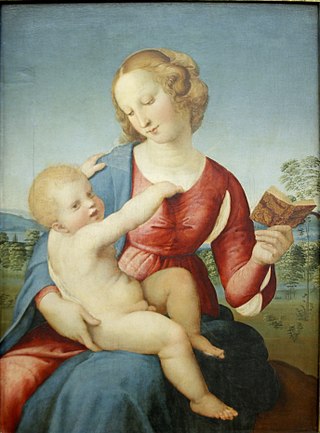
The Madonna Colonna is an oil on poplar painting by the Italian Renaissance artist Raphael. It was painted c. 1507–1508, near the end of Raphael's Florentine period.

The Portrait of Andrea Navagero e Agostino Beazzano is a painting by the Italian High Renaissance painter Raphael, created in 1516. It is housed in the Galleria Doria Pamphilj, Rome.
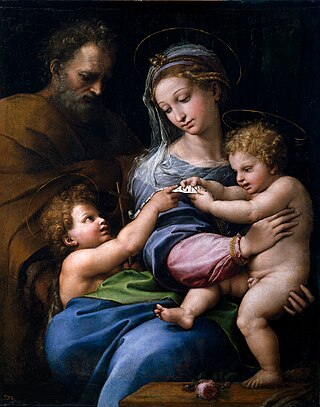
The Madonna of the Rose is a 1518-1520 painting, now in the Museo del Prado in Madrid. Its attribution as by Raphael is uncertain, and the involvement of Giulio Romano cannot be excluded. The rose and the lower portion were added at a later date by an unknown artist. A second autograph version of this painting, without the added rose and lower strip, painted on wood panel, is owned by real estate magnate Luke Brugnara. In 2022, the painting was included in an exhibition held by the National Gallery.

The Holy Family is a 1518 painting of the Holy Family, Saint Elisabeth, an infant John the Baptist and two angels. It is signed by Raphael, but most of the work was delegated to his workshop assistants. It was commissioned by Pope Leo X as a gift to Claude, wife of Francis I of France, hence its name. It is now in the Louvre.
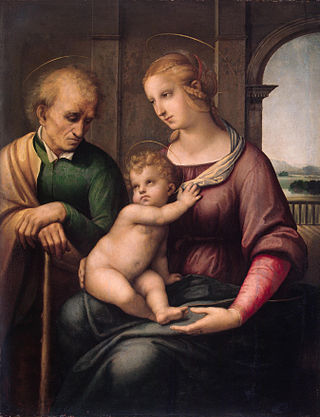
The Madonna with Beardless Saint Joseph is an early painting by Raphael, executed c. 1506, now at the Hermitage Museum. It depicts Saint Joseph, the Virgin Mary, and the Christ Child.

The Portrait of Cardinal Bibbiena is a painting of Cardinal Bernardo Dovizi da Bibbiena by Raphael, created around 1516. It is currently housed in the Palazzo Pitti in Florence. The rendering appears more rigid than usual for Raphael, leading some critics to attribute it to one of his pupils or suggest it may be a copy of a lost original by the artist.
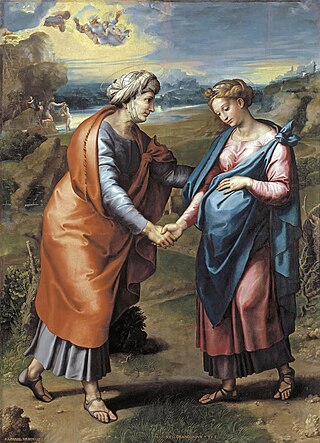
The Visitation is a c. 1517 painting of the Visitation of the Virgin Mary to Saint Elizabeth by Raphael, in the Prado Museum since 1837. Commissioned by the Apostolic Protonotary Giovanni Branconio at his father Marino's request for their family chapel in the church of San Silvestre in Aquila, it was plundered by the occupation troops of Philip IV of Spain in 1655 and placed at El Escorial.

The Perla of Modena is an oil on panel painting, dated to 1518-1520 and now attributed to Raphael. It is now in the Galleria Estense in Modena.

The Madonna of the Baldacchino is a c.1506-1508 oil on canvas holy conversation-style painting by Raphael, now in the Galleria Palatina in Florence.

Portrait of a Young Woman is a c.1518-1519 oil on panel painting by Raphael and Giulio Romano, now in the Musée des Beaux-Arts in Strasbourg, for which it was acquired by Wilhelm von Bode, who bought it in London in 1890. It was previously recorded in London in the Acton collection. Its inventory number is 175.
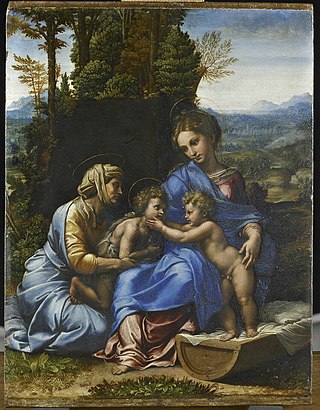
The Small Holy Family is an oil-on-panel painting by Raphael and assistants, now in the Louvre in Paris. Its name distinguishes it from his Great Holy Family, also in the Louvre. It is signed and dated "RAPHAEL VRBINAS S[anti] PINGEBAT MDXVIII" on the hem of the Madonna's garment.

Holy Family under an Oak Tree or Madonna of the Oak Tree is an oil-on-panel painting by the Italian Renaissance artist Giulio Romano using a composition or underdrawing by Raphael. It is now in the Prado in Madrid. It is dated to c. 1518 by its stylistic similarities to other works produced by the two artists around that time such as La Perla (Prado). In the background is a valley reminiscent of that of the River Tiber, with a ruin on a hill to the left based on the Basilica of Maxentius or the Baths of Caracalla.

Saint John the Baptist as a Boy is a c. 1518-1519 oil on canvas painting by the studio of Raphael, now in the Uffizi in Florence.

Saint John the Baptist in the Desert is an oil painting of c. 1516–1517 by Raphael and his assistants, including Giulio Romano. The composition is thought to be by Raphael himself, who may also have drafted some of the sections of the finished work. It is now in the Louvre in Paris. Originally on panel, it was transferred to a canvas support in 1777; the practice was quite common in French collections in that period.

The 'Diotallevi Madonna is an oil on panel painting by Raphael, created c. 1504. It is held in the Bode Museum, in Berlin, where it entered in 1841-1842 from Marquess Diotallevi's collection in Rimini. Previously attributed to Raphael's teacher Perugino, almost all art historians now attribute it to Raphael, with the exception of Adolfo Venturi who attributes it and parts of Perugino's Madonna della Consolazione to an anonymous, "Master of the Diotallevi Madonna".

The Bridgewater Madonna is a religious painting by Raphael, dated 1507. Originally on oil and wood, but later transferred to canvas, it measures 81 by 55 cm. The picture is part of the permanent collection of the Scottish National Gallery in Edinburgh, on loan from the Duke of Sutherland Collection.



















